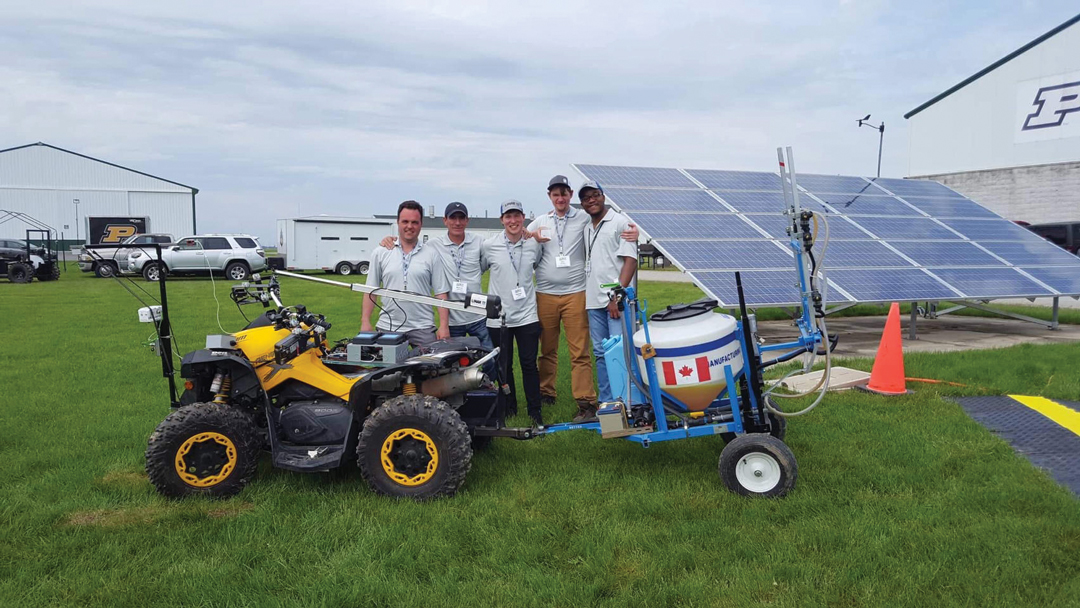FOR THE LOVE OF WHEAT
BY IAN DOIG • ILLUSTRATION BY EMILY CHU
Gurcharn Singh Brar jokes that he’s in a long-term relationship with wheat. He grew up on a small rice and wheat farm in India’s Punjab state, though his rural upbringing didn’t at first set him on an agricultural career path. He initially wished to become a medical doctor but earned admission to the prestigious Punjab Agricultural University. There he developed a scientific fascination with wheat, and even displays his commitment to the crop by wearing a golden wheat spike pendant.
From the breadbasket of India, he moved to the breadbasket of Canada in 2012. At the University of Saskatchewan’s Crop Development Centre, he studied wheat pathology. Focused on wheat rust, he completed a master’s degree and, at the urging of his supervisors, a PhD in wheat breeding for which he studied Fusarium head blight resistance. This was followed by four years as an assistant professor at the University of British Columbia where he studied the genetics of disease resistance and drought tolerance in wheat and barley. His ambition was to develop or lead a wheat breeding program. “Plant breeders have a very tangible impact on the lives of growers,” said Brar. “That’s very, very fulfilling.”
When Dean Spaner retired as head of the University of Alberta wheat breeding program in July 2023, Brar eagerly applied to fill this vacancy.
GrainsWest: What is your approach to crop breeding?
Gurcharn Brar: Canadian breeders produce some of the world’s best quality wheat. There are hundreds of varieties a grower can choose, but do we really need all these? I will be very happy if I commercialize, say, only 10 wheat varieties in my whole career. But these 10 varieties should be unique and should provide extra advantages for farmers. And it will be easier for growers to choose among those varieties.
I’m a strong advocate of public research and public wheat breeding. It is very important for Canadian growers, Canadian producer groups and everybody associated with agriculture to keep supporting public research.
GW: What resources and staff does the breeding program have at its disposal?
GB: I work with 10 staff members. Thanks to our producer groups—Alberta Grains, Manitoba Crop Alliance, SaskWheat, BC Peace River Grain Industry Development Council—for their core breeding funding, which is very important for the functioning of the program. Plant breeding programs require large financial investment because we need many technicians. This program is quite productive and has lots of potential. I look forward to exploiting that potential in a good way to bring the best out of it for the next 25 or 30 years.
GW: How will the U of A program meet its breeding goals, and what is its timeline to deliver new varieties for Alberta’s northern Parkland region?
GB: It takes nine to 11 years before farmers get the seed in their hand. That timeline is reasonable. So, we need to envision what the priorities of growers will be 10 years down the road.
We are one of North America’s northernmost wheat breeding programs. We are in an ideal location to breed for the Parkland region. And there is more grain acreage to the north of Edmonton on the Prairies, including the B.C. Peace region, than in the whole province of Manitoba.
However, I will not exclusively breed for the Parkland region. I have three main breeding goals in the two market classes. One is high-yielding CPS wheat. And I will breed CWRS wheat for the Parkland region and the standard Prairies.
GW: What challenges do you face in the development of new varieties for the northern Prairies?
GB: The biggest challenge is developing varieties that are early maturing yet high yielding. If you look at the Parkland region, growers are still growing varieties like AAC Brandon and AAC Viewfield, which are not necessarily early maturing. Sometimes farmers may think they don’t need early maturing varieties, but one in five years they can get an early frost, and it damages the crop because of pre-harvest sprouting.
Also, the Parkland region gets more moisture. This means plant varieties suitable for southern Alberta or southern Saskatchewan grow taller and then lodge. We have to breed shorter, early maturing varieties with strong straw. However, when we introduce shortness and early maturity in a variety, yield goes down.
Today, we need a variety that yields like Brandon or Viewfield and has the maturity of Parata, which is five days earlier maturing than standard wheat varieties. Five days can make a lot of difference. That will be a game changer.
GW: How tricky is it to produce varieties that perform well in the field yet have high-quality end-use characteristics?
GB: Each wheat breeder runs two programs. One is breeding and one is genetics. Breeding is all about developing varieties, and genetics is improving traits and developing the parent plants for crosses that will give us a variety.
Wheat breeders deal with more than 20 quality traits they stack in a variety. Each trait should be above a certain threshold. As far as quality goes, it is challenging to breed a perfect variety. For example, when we cross a non-Canadian line from a non-adapted region, we start to deal with a lot of end-use quality problems. You cross the best, you hope for the best.
For example, most of the lines our program developed have poor Fusarium resistance relative to other programs. We do have elite breeding lines with really good Fusarium resistance, but these probably have poor performance for some of the end-use quality traits.
It’s challenging, but it’s not impossible. And again, it’s about choosing the right parents for crosses. But if we do it right, and if we have large enough breeding populations to select from, it is possible to breed varieties which are very high yielding, early maturing and have premium end-use quality traits that meet the requirements of the CWRS class.
GW: Will emerging data technologies, such as artificial intelligence (AI) further enhance the breeding process for your program?
GB: These technologies are beneficial for research and will add value to the breeding process. But breeding is about making crosses, and there is no quicker way to grow the wheat. AI will be of use for discovery, maybe characterizing traits relevant to breeding, but for developing varieties, phenotyping and the actual field work and making crosses, I don’t think
AI can expedite the process. It can be one of the many tools that we use to make selections or add value to the breeding pipeline, but nothing more than that.
GW: What’s next for the U of A breeding program?
GB: The U of A breeding program has done very well in the past, and I hope to take it a few steps forward. With the varieties Dean Spaner developed over the last few years, we have good germplasm to work with to breed even better varieties. The program shares and exchanges germplasm with other public wheat breeder colleagues at Agriculture and Agri-Food Canada and universities. That’s crucial for public wheat breeding. But my biggest goal is to increase the [acreage of U of A varieties under cultivation]. That can only happen if we bring forward very competitive varieties, and that requires a lot of time and dedication. I am very keen to contribute to an impactful breeding program Alberta farmers can take pride in.
This is the only Alberta program that breeds for the CWRS class. And we will need more financial support from producer groups over the coming years. With that additional support, we will achieve good results in the short and long term.







Comments